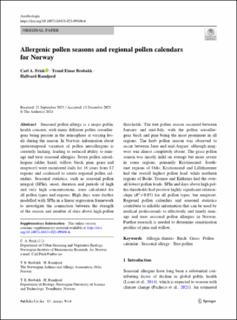| dc.description.abstract | Seasonal pollen allergy is a major public health concern, with many different pollen aeroallergens being present in the atmosphere at varying levels during the season. In Norway, information about spatiotemporal variation of pollen aeroallergens is currently lacking, leading to reduced ability to manage and treat seasonal allergies. Seven pollen aeroallergens (alder, hazel, willow, birch, pine, grass and mugwort) were monitored daily for 16 years from 12 regions and coalesced to create regional pollen calendars. Seasonal statistics, such as seasonal pollen integral (SPIn), onset, duration and periods of high and very high concentrations, were calculated for all pollen types and regions. High days were further modelled with SPIn in a linear regression framework to investigate the connection between the strength of the season and number of days above high pollen thresholds. The tree pollen season occurred between January and mid-July, with the pollen aeroallergens birch and pine being the most prominent in all regions. The herb pollen season was observed to occur between June and mid-August, although mugwort was almost completely absent. The grass pollen season was mostly mild on average but more severe in some regions, primarily Kristiansand. South-east regions of Oslo, Kristiansand and Lillehammer had the overall highest pollen load, while northern regions of Bodø, Tromsø and Kirkenes had the overall lowest pollen loads. SPIn and days above high pollen thresholds had positive highly significant relationships (R2 > 0.85) for all pollen types, bar mugwort. Regional pollen calendars and seasonal statistics contribute to reliable information that can be used by medical professionals to effectively and timely manage and treat seasonal pollen allergies in Norway. Further research is needed to determine sensitization profiles of pine and willow. | en_US |

